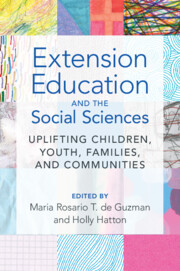Book contents
- Extension Education and the Social Sciences
- Extension Education and the Social Sciences
- Copyright page
- Contents
- Contributors
- Part I Overview of Extension and the Social Sciences
- Part II Addressing Key Issues in the Well-Being of Children, Youth, and Families
- Chapter 5 Extension’s Role in Supporting Young Children’s Well-Being
- Chapter 6 Supporting Youth through Family Engagement
- Chapter 7 The Application of Social Science in 4-H Youth Development
- Chapter 8 Promoting Healthy Behaviors and Communities through Food, Nutrition, and Health Extension Efforts
- Chapter 9 Youth Entrepreneurship Education
- Part III Looking Ahead: Emerging Issues and Trends
- Index
- References
Chapter 7 - The Application of Social Science in 4-H Youth Development
from Part II - Addressing Key Issues in the Well-Being of Children, Youth, and Families
Published online by Cambridge University Press: 28 March 2024
- Extension Education and the Social Sciences
- Extension Education and the Social Sciences
- Copyright page
- Contents
- Contributors
- Part I Overview of Extension and the Social Sciences
- Part II Addressing Key Issues in the Well-Being of Children, Youth, and Families
- Chapter 5 Extension’s Role in Supporting Young Children’s Well-Being
- Chapter 6 Supporting Youth through Family Engagement
- Chapter 7 The Application of Social Science in 4-H Youth Development
- Chapter 8 Promoting Healthy Behaviors and Communities through Food, Nutrition, and Health Extension Efforts
- Chapter 9 Youth Entrepreneurship Education
- Part III Looking Ahead: Emerging Issues and Trends
- Index
- References
Summary
4-H, which is the largest youth organization in the country, has evolved over time. Historically, there has been a disconnect between university-based researchers and practitioners who implement 4-H programs in the field. In part because of this mismatch and because there has been a focus on subject matter content, 4-H as an organization has struggled with articulating the theory of change that underlies its programming. Recent developments in understanding the science of learning and development and recent efforts to translate positive youth development research into practice are promising. Based at land-grant universities, 4-H is well positioned to capitalize on these developments and intentionally apply them in practice. This chapter highlights 4-H programming examples to illustrate developmental principles and concludes with next steps to address challenges and increase alignment with developmental science.
- Type
- Chapter
- Information
- Extension Education and the Social SciencesUplifting Children, Youth, Families, and Communities, pp. 137 - 165Publisher: Cambridge University PressPrint publication year: 2024



